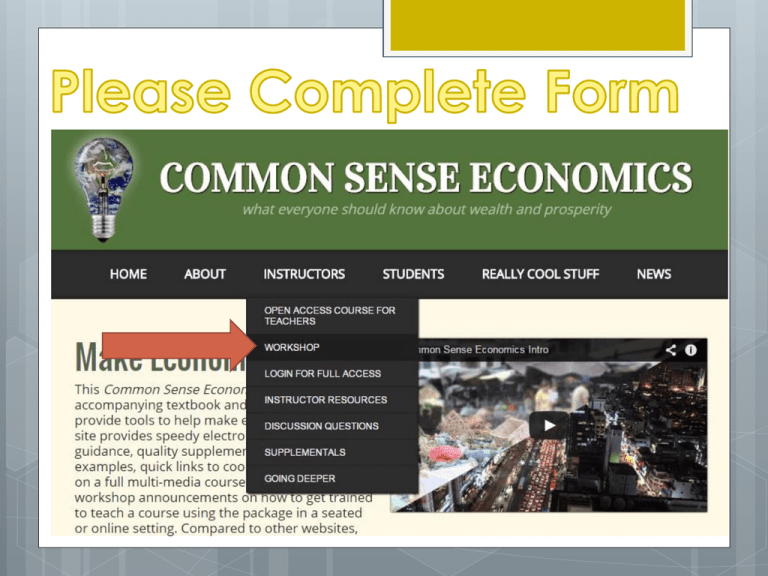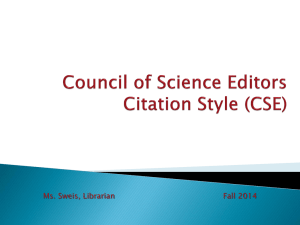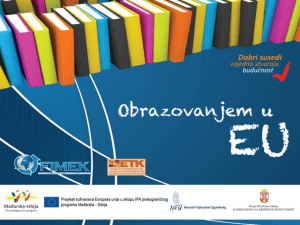CSE One-Day Workshop_JC_suggestions
advertisement

CommonSenseEconomics.com Workshop Is your device workshop ready? Visit: device readiness CommonSenseEconomics.com Instructor resource tab/Choose workshop Complete the participation form Browse through the Instructor’s Manual Common Sense: Economics for Life! Course Presenter 1 Turn on the learning light! Presenter 2 Presenter 3 Common Sense: Economics for Life! Course Turn on the learning light! Workshop Overview Agenda Introductions the room around Turn on the learning light Focuses on what students need to know to make sound decisions as individuals and citizens Addresses how markets and political processes work Addresses personal finance and economics Uses technology to excite and motivate the multi-media generation of students to learn Revealed Preferences: Multi-media Generation of Students (8-18) TV remains the dominant type of media content consumed, at 4:29 a day. It is followed by: Music/audio at 2:31; Computers at 1:29; Video games at 1:13; Print at 0:38, and Movies at 0:25 a day. Multi-media Generation (8-18) Time spent with every medium other than movies and print increased over the past five years: 0:47 0:38 0:27 0:24 a day increase for music/audio for TV content for computers, and for video games. Reference: Rideout, V. J., Foehr, U. G., & Roberts, D. F. (2010). Generation M2 : Media in the lives of 8 to 18 year Olds. Retrieved from Kaiser Family Foundation at www.kff.org/entmedia/upload/8010.pdf This course is fun! Common Sense Economics (2010) by Gwartney, Stroup, Lee and Ferrarini, St. Martin’s Press Economical (Hardback $15.95 and Kindle $10.99) Concise Divided into four parts: key elements of economics; institutions for prosperity; economics of political decision-making; personal finance Learning light, cont. Stresses reasoning rather than mechanics User-friendly, well-organized, and easy to understand The package is ready to go! It contains everything the instructor needs to teach economics and personal finance. History behind the package U.S. is a nation of many economic and personal finance illiterates. Six master teachers came together to help change this. They decided to focus on those students who may take only one economics/personal finance course. For over five years, the specialized expertise and dedicated work has been used to design, implement and improve on this successful course package. Yes! It’s easy for instructors and administrators to say “Yes” to Common Sense: Economics for Life! for high school and college students. The course is now offered successfully at universities, community colleges, and high schools. The course connects to national standards and benchmarks. Sample Adoptions Florida State University Northern Michigan University Florida Department of Education Wake Forest Community College Detroit Public Schools Macomb Intermediate School District Offered in a variety of classroom settings Face-to-face Online Blended Satellite (F2F) F2F Classroom Activities Classroom lessons have been identified for each core module. Support is provided by the Council on Economic education and the Fraser Institute. Most lessons are selected from Virtual Economics which may be purchased through your state council or the Council on Economic Education Overview: The Core Package Pre- (and-post) test of economics and survey attitudes toward markets and government 15 learning modules built around key concepts 15 sets of discussion board questions and answer keys High quality videos, podcasts and classical and contemporary readings 15 practical assignments 4 supplemental units 10 controversies in economics 2 comprehensive test banks for randomly generated quizzes and tests of 60 concepts Each module provides 1. High quality pre-learning questions to get students thinking about relevant issues 2. Key concepts and learning objectives 3. Power Point learning guide 4. Read, watch and listen 5. Practical assignment 6. Act: Quiz or exam 7. Act: Post-learning responses using the economic way of thinking to improve initial reply. References expected. 8. Act: A transition to bring students immediately into the next module Common Sense Economics: Four Themes Part I. Twelve Key Elements of Economics Part II. Seven Major Sources of Economic Progress Part III. Economic Progress and the Role of Government Part IV. Twelve Key Elements of Practical Personal Finance Part I. Twelve Key Elements of Economics 20 The Twelve Key Elements of Part I will… Provide a bridge between common sense and basic principles of economics. Help you begin to think economically. Provide important insights regarding how the world really works. Part I. Twelve Key Elements of Economics 1. Incentives matter. 2. There is no such thing as a free lunch. 3. Decisions are made at the margin. 4. Trade promotes economic progress. 5. Transaction costs are an obstacle to trade. 6.Prices bring the choices of buyers and sellers into balance. Part I. Twelve Key Elements of Economics 7. Profits direct businesses toward activities that increase wealth. 8. People earn income by helping others. 9. Production of goods and services people value, not just jobs, provides the sources of high living standards. Part I. Twelve Key Elements of Economics 10. Economic progress comes primarily through trade, investment, better ways of doing things, and sound economic institutions. 11. The “invisible hand” of market prices directs buyers and sellers toward activities that promote the general welfare. 12. Too often long-term consequences, or the secondary effects, of an action are ignored. Part I. Module 1 Watch Slice of Life Read CSE pages 5-13 (Sections 1.1, 1.2, and 1.3) Watch 3 videos Listen and/or Read 4 items Slice of Life videos We believe this series will help keep students focused on the key points, stimulate their interest in the readings, videos, and audios of each module, and illustrate why it is important to integrate the economic way of thinking into our lives. Plus, it will help make economics more exciting in both seated and online classes, which will enhance the learning of our students. CSE pages 5-13 (Sections 1.1, 1.2, and 1.3) What are incentives? Why are examples of how changes in incentives change behavior? Is free medical care or free education “free?” What are marginal decisions? Can you think of a new example of a marginal decision? 3 videos: CSE 1.1 Freakonomics- Potty training incentives (3:33) CSE 1.2 Solman- Opportunity cost (5:45) CSE 1.3 Learn Liberty- Thinking at the Margin (3:52) All videos are made available to instructors as stand-alone files that can be played directly from a computer in the classroom (Apple and PC) or streamed from Critical Commons All videos are captioned for ADA compliance 4 items: CSE 1.1 “The Power of Incentives” by Dwight Lee (Audio 8:19 minutes) CSE 1.2 “The Road Not Taken” by Robert Frost (Audio, 1:39 minutes) CSE 1.2 “Opportunities and Costs” by Dwight Lee (Audio, 8:45 minutes) CSE 1.3 “Markets and Marginalism” by Dwight Lee (Audio, 7:58 minutes) Practical assignment Quiz (or exam) Discussion board Get ready for the next module Let’s take a closer look Visit: CommonSenseEconomics.com Instructor Resources Tab Workshops Tab Enter the demo site. Look at Modules 1, 5, 8 and 12 Turn to your right and left. Offer assistance or seek help. DEMO SITE Part I. Module 2 Watch Slice of Life Read CSE pages 13-21 (Sections 1.4, 1.5, and 1.6) Watch 4 videos Listen and/or Read 2 items Part I. Module 3 Watch Slice of Life Read CSE pages 21-29 (Sections 1.7, 1.8, and 1.9) Watch 5 videos Listen and/or Read 2 items Part I. Module 4 Watch Slice of Life Read CSE pages 30-39 (Sections 1.10, 1.11, and 1.12) Watch 4 videos Listen and/or Read 1 item Part II. Seven Major Sources of Economic Progress Part II. Seven Major Sources of Economic Progress 1. 2. 3. 4. 5. 6. 7. Legal System Competitive Markets Limits on Government Regulation An Efficient Capital Market Monetary Stability Low Tax Rates Free Trade Per Capita Income: The last 1000 years • Income stagnated for the 800 years following year 1000, but growth has exploded during the last 200 years. • (Measured in 1990 dollars) world per capita income was $667 in 1820 – only about 50% higher than year 1000. By 2003, however, income had risen to $6,516 – 10 times the level of 1820. • During the past 200 years, the income growth of the high-income industrial countries (West) has grown even more – nearly 20 fold. $25,000 GDP Per Capita 2003: $23,710 $20,000 West GDP per capita $15,000 2003: $6,516 $10,000 World GDP per capita 1820: $1,202 $5,000 1820: $667 1000 1100 1200 1300 1400 1500 1600 1700 1800 1900 2003 Part II. Module 5 Watch Slice of Life Read CSE pages 45-57 (Sections 2.1 and 2.2) Watch 6 videos Listen and/or Read 3 items Part II. Module 6 Watch Slice of Life Read CSE pages 57-73 (Sections 2.3, 2.4, and 2.5) Watch 5 videos Listen and/or Read 1 item Part II. Module 7 Watch Slice of Life Read CSE pages 73-89 (Sections 2.6 and 2.7) Watch 6 videos Listen and/or Read 2 items Lunch Time Afternoon Good afternoon! Are you ready? Engaged? Any thoughts to share? Part III. Economic Progress and the Role of Government Part III. Economic Progress and the Role of Government 1. 2. 3. Government promotes economic progress by protecting the rights of individuals and supplying a few goods that are difficult to provide through markets. Allocation through political voting is fundamentally different from market allocation, and economic analysis indicates that the latter is more consistent with economic progress. The costs of government are not only taxes. Part III. Economic Progress and the Role of Government 4. 5. 6. 7. Unless restrained by constitutional rules, special-interest groups will use the democratic political process to fleece taxpayers and consumers. Unless restrained by constitutional rules, legislators will run budget deficits and spend excessively. Government slows economic progress when it becomes heavily involved in providing favors to some at the expense of others. The net gain to those receiving government transfers is less, and often substantially less, than the amount they receive. Part III. Economic Progress and the Role of Government 8. Central planning replaces markets with politics, which wastes resources and retards economic progress. 9. Competition is just as important in government as in markets. 10. Constitutional rules that bring the political process and sound economics into harmony will promote economic progress. Part III. Module 8 Watch Slice of Life Read CSE pages 95-106 (Sections 3.1, 3.2, and 3.3) and “The Economics of Market Failure” Watch 5 videos Listen and/or Read 1 item Economic Efficiency Economists use the standard of economic efficiency to judge economic outcomes. Both governments and markets have problems with efficiently allocating resources. Two Key Roles for Government Protection of property rights Production of public goods - - goods that if they are available to one person, they are available to everyone and it is impossible to restrict consumption to only those who pay. Market Failure Markets fail due externalities - - Costs or benefits imposed on a non-consenting third party. Negative externalities: Pollution, traffic, noise, over-fishing, and so forth. Positive externalities: A freshly painted home or a scientific breakthrough. There may be a role for government in reducing negative externalities. Government Failure • Nobel Laureate James M. Buchanan introduced the idea of “government failure.” – Government failure occurs when a government intervention causes a more inefficient allocation of goods and resources than would occur without that intervention. How Governments Fail Special interest group effect Shortsightedness effect Government does not allocate based on mutual consent; Voters makes choices based on a “bundle” of positions held by a candidate Let’s Go Shopping! Political vs. Market Allocation Demonstration lesson Allocation through voting is fundamentally different than market allocation Rate the Items in Carts 1 and 2 Rate your cart: 10 = You really desire the item; gain a lot if you pay the price. -10 = You would be extremely unhappy being forced to purchase the item at any price. 0 = You are indifferent to having the item. And the Winner Is? Which cart had the highest value? Everyone receives the items in the winning cart! That’s the democratic solution! How do you feel about that? What might we be able to conclude? Decisions made using democratic processes do not always make individuals better off. Imagine Cart 3 Pretend you have $75 and a new, empty cart 3. Browse the items in cart 1 and 2 that you placed a high value on -- 5 or 10 rating. Total up the value (not the prices) of your items. Purchase the ones you want by circling the price. Don’t spend over $75. Total up what you paid. What did cart 3 cost? What might we conclude from your cart 3 choices? So which method of choice is most economically efficient? The market method of choice appears to be the most economically efficient in that gives us the greatest value at a lower cost. Is this an unusual result? Other Results Part III. Module 9 Watch Slice of Life Read CSE pages 106-115 (Sections 3.4 and 3.5) Watch 4 videos Listen and/or Read 1 item Part III. Module 10 Watch Slice of Life Read CSE pages 115-131 (Sections 3.6, 3.7, and 3.8) Watch 5 videos Listen and/or Read 2 items Part III. Module 11 Watch Slice of Life Read CSE pages 131-143 (Sections 3.9 and 3.10) Watch 4 videos Listen and/or Read 0 items Part IV. Twelve Key Elements of Practical Personal Finance Part IV. Twelve Key Elements of Practical Personal Finance 1. 2. 3. 4. Discover your comparative advantage. Be entrepreneurial. In a market economy, people get ahead by helping others and discovering better ways of doing things. Use budgeting to help you save regularly and spend your money more effectively. Don't finance anything for longer than its useful life. Part IV. Twelve Key Elements of Practical Personal Finance 5. 6. 7. 8. Two ways to get more out of your money: Avoid credit-card debt and consider purchasing used items. Begin paying into a "real-world" savings account every month. Put the power of compound interest to work for you. Diversify- don't put all of your eggs in one basket. Part IV. Twelve Key Elements of Practical Personal Finance 9. 10. 11. 12. Indexed equity funds can help you beat the experts without taking excessive risk. Invest in stocks for long-run objectives, but as the need for money approaches, increase the proportion of bonds. Beware of investment schemes promising high returns with little or no risk. Teach your children how to earn money and spend it wisely. Part IV. Module 12 Watch Slice of Life Read Watch CSE pages 149-161 (Sections 4.1, 4.2, and 4.3) 7 videos Listen and/or Read There are no additional audios or readings in the personal finance part of this course. You are now asked to put your new knowledge to work. So expect an increase in the number of assignments. Plan accordingly. Assignment 12.2 “Zero-based Budgeting Guide” Trade-offs, opportunity costs, spend, save and invest for now and the future Budgeting Basics (1) Gross annual income: $40,000 What your net annual takehome pay? Monthly net take-home pay? Bi-weekly or net take-home pay every two weeks? Federal income taxes: $940 a year Payroll tax deductions: $3060 a year (7.65%) Scavenger Hunt with Your Neighbor: CSE Demo Site Find Paul Solman- Opportunity Cost in Module 1. (Watch) Find Running Out of Agricultural Land in Module 5. (Listen) Find Assignment Budget Basics in Module 12. (Assignment) Part IV. Module 13 Watch Slice of Life Read CSE pages 162-168 (Sections 4.4, 4.5, and 4.6) Watch 4 videos Part IV. Module 14 Watch Slice of Life Read CSE pages 168-178 (Sections 4.7, 4.8, and 4.9) Watch 3 videos Part IV. Module 15 Watch Slice of Life Read CSE pages 178-190 (Sections 4.10, 4.11, and 4.12) Watch 4 videos Ten Controversies 1. 2. 3. 4. 5. 6. 7. 8. 9. 10. Kidneys Cash for Clunkers Oil Supplies Price Gouging Sweatshops Gender Wage Gap Eminent Domain Needy or Greedy Seniors? Spending, Taxes, and the Role of Government How Not to Help the Poor Ask students to consider the following as they watch each video… What is the controversy? What is the economic argument? What element of economic thinking is involved? What is the non-economic argument? What appeals are being made in the noneconomic argument? Supplemental Modules Economics Going Deeper A. Supply, Demand, Dynamic Change, and Price Controls B. GDP, Inflation, and Unemployment C. Fiscal and Monetary Policy D. The Economics of the Great Depression , Great Recession, and Unemployment Supplemental Modules Economics and Values E. Economics, Work, and Happiness F. Economics, Markets, and Morality G. The Economics of Poverty H. The Economics of the Environment Supplemental Modules Personal Finance I. Smart Choices for Earning More Income J. Smart Choices for Saving and Investing K. Smart Choices for Managing Credit L. Smart Choices for Insurance CSE Wrap Up and Cooperative Relations Complete workshop evaluation Learning Management Systems Instructor’s Manual Register for upcoming courses How to stay connected Join the CSE Open Access Course Email us- see brochure. Email new videos, class activities, and ideas to CommonSenseEconomics@gmail.com Friend us on Facebook. Questions?









